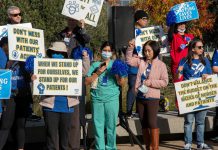I’ve seen the June South County Caltrain ridership numbers (Monday-Friday, four trains north in the morning and four trains south in the evening): Gilroy 126 riders/day; San Martin 22 riders/day; Morgan Hill 104 riders/day; Blossom Hill 68 riders/day; Capitol 45 riders/day.
It’s not fiscally responsible to fund Caltrain South County at $15 million for 365 riders/day M-F when they aren’t serving the current commute travel patterns and while VTA is facing a fiscally constrained FY26 and FY27 Transit Operating Budget. Caltrain is heading into a deficit for FY27 too.
These five stations south of Tamien are not electrified and Caltrain doesn’t own the tracks; Union Pacific Railroad does. South County Caltrain service doesn’t have the impact needed to relieve congestion on U.S. Route 101 today or historically.
We continue to talk about this at our South County VTA agenda preparation meetings with VTA staff and Caltrain staff. VTA plays a role in our development review process, Caltrain doesn’t.
We are focused on moving the most people on mass transit from Gilroy to Diridon. We track and budget the ridership/cost from both agencies and have been comparing them for a long time. When ridership is low, services get cut—that’s a given.
As of June 2025, the VTA’s Frequent 68 (San Jose to Gilroy every day) runs every 15 minutes and averages 4,309 daily boardings; and the Rapid 568 (San Jose to Gilroy Monday-Friday) runs every 30 minutes and averages 853 daily boardings. I’ve been keeping track for a few years and reporting out the numbers at Gilroy City Council meetings and my newsletters.
Those are numbers to support the cost to operate, while we continue to shift residents to transit through local policies, programs, and marketing.
Caltrain plans on putting the full burden of the South County Caltrain (Capitol, Blossom Hill, Morgan Hill, San Martin, Gilroy) cost onto VTA and it starts at $15 million. More trains or increased frequency will increase that cost.
Caltrain operations should not be funded from VTA Transit funds, 2000 Measure A funds, or 2016 Measure B Caltrain Corridor Capacity. There are no grants that would be beneficial in funding this current level of service and ridership.
Caltrain is currently using federal tax funds to operate South County Caltrain and that is about to run out. Those funds could be better spent on service that meets the needs for mass transit. Gilroy isn’t the starting point for traffic any longer. San Benito County and Monterey County drivers contribute to it as well.
The state provided funding for one battery powered train (not four) which will serve as a pilot and it is supposed to run on the electrified system from Diridon to SF. The last update I received is this is not going to happen in FY26 or FY27.
VTA, Caltrain and South County communities do minimal to increase South County Caltrain ridership, so the expectation that suddenly ridership on Caltrain will increase is not a reality today. It’s not fiscally responsible to fund $15 million for 365 riders/day M-F. Enhancing the current South County ridership of the Frequent 68 and Rapid 568 lines is the more fiscally responsible path for these next two years.
I encourage both VTA and Caltrain to pause South County Caltrain service while we work collaboratively with all partners on ways to double track or purchase the existing tracks with a goal to have the same service levels as Tamien to San Francisco. Continue to enhance the successful current services on the VTA Frequent 68 and Rapid 568 bus lines that currently serve thousands of daily riders from South County.
I am proud to represent Gilroy on the Valley Transportation Authority (VTA) Policy Advisory Committee (PAC) and CalTrain Local Policy Maker Group (LPMG) in 2025.
Zach Hilton
Gilroy City Councilmember














Yes, the ridership may be low, but dear Mr. Hilton, you aren’t looking at the whole picture. It is unfortunate that there is a lack of service for this train run, therefore lack of ridership because the limited train schedules prevent CalTrain to south county as a viable option. I truly believe that if CalTrain was made more usable, it will take a lot of car traffic off of 101. We are increasingly more urbanized, and if CalTrain was a better option and could attract commuters from the other counties that would be wonderful.
I was a happy commuter taking CalTrain from Redwood City to San ‘Francisco for a few years, and enjoyed the convenience of not being stuck in car traffic, being able to relax and not paying for parking downtown. Proper connection to MUNI and the frequency of trains made it totally feasible. Unfortunately, because the South Bay is built to accommodate mostly private vehicles, VTA is way more cumbersome, and CalTrain is virtually unusable for the average Silicon Valley employee.
I would rather see an increase in train scheduling with better support from VTA to accommodate connections to and from CalTrain stations throughout the South County, rather than having bus lines run from shopping mall to shopping mall.
Dear Michael, Why did you take down my comment? Do you want me to retype it? Please advise. Joe Thompson (408) 607–7351 cell phone
If my math is right, the subsidy is about $112 per ride. Think about that when you are deciding how you will vote on the upcoming county sales tax increase this fall. It’s not the same accounts, but still not the the best use of the money.
Besides, why should fares be subsidized at all?
Dear Friends, Calculating the true subsidy is impossible using their data because they do not use legal accounting methods. IRS & FTB regs require everyone to use GAAP accounting methods. But all of the transit agencies don’t do that. They use the same “off book accounting” that Enron used, and Bernie Madoff used. They omit their capital & fixed costs. If one of my clients did that they’d be prosecuted for false advertising and violation of the Unfair Business Practices Act, and RICO, etc. If we had elected people running transit agencies, instead of appointed ones, then maybe they would obey the law and tell the truth about the full extent of their insolvency. Instead, we have governance without our consent, where fraud, waste & abuse run rampant year-in and year-out to protect the special interests who feast off the motorists gas tax subsidies. Caveat viator. Joe Thompson, Past-Chair, Legislation Committee, Transportation Lawyers Assn. Past-President 1999-2001, 2006, Gilroy-Morgan Hill Bar Assn.; (408) 848-5506; E-Mail: Tr******@*****ll.Net
So what is a little legerdemain in paradise?
How many of Zach Hilton’s anti Caltrain Op Ed’s will Gilroy Dispatch publish? Maybe they will just make this a monthly feature.
Zach, I think you should reevaluate your numbers. I took the 4pm train from Diridon to Gilroy, the car I was on was nearly full, yes, nearly full. People were sitting alongside strangers just to have a seat.
Additionally, your Aug 11 letter about building more dense housing in Gilroy is a great step forward, but how will those moving to said new housing afford it? The largest employer in Gilroy is Costco, are we to assume that every new resident in Gilroy is going to afford housing in Gilroy while working in Gilroy? I am not sure that is feasible, thus there will be new commuters sharing the already congested roadways.
Train service from Gilroy is a fast and effective way to get from the South Bay to the Bay area where a lot more employment opportunities exist.
I would love to see a third party conduct an analysis of commuters using the South Bay connection service, either by looking at clipper data or counting riders at stations.
Zach, I think you should reevaluate your numbers. I took the 4pm train from Diridon to Gilroy, the car I was on was nearly full, yes, nearly full. People were sitting alongside strangers just to have a seat.
Additionally, your Aug 11 letter about building more dense housing in Gilroy is a great step forward, but how will those moving to said new housing afford it? The largest employer in Gilroy is Costco, are we to assume that every new resident in Gilroy is going to afford housing in Gilroy while working in Gilroy? I am not sure that is feasible, thus there will be new commuters sharing the already congested roadways.
Train service from Gilroy is a fast and effective way to get from the South Bay to the Bay area where a lot more employment opportunities exist.
I would love to see a third party conduct an analysis of commuters using the South Bay connection service, either by looking at clipper data or counting riders at stations.
Oh please, Zach Hilton. This anti-Caltrains, pro-VTA drumbeat is getting tiresome. You are vilifying the very hard working and tax paying citizens you were elected to represent. And might I add attempting to take away one of the only “benefits” we hard working, tax paying constituents still have! If we relied solely on VTA for transport, we would have been up a creek when they decided to go on strike awhile back! You should well know it’s never wise to put all your eggs in one “bureaucratic” basket! It won’t end well. Yes, it costs a bit per rider, but I’m sure if you look at the numbers, we spend as much per homeless person in the area as we do on those of us relying on Caltrain for our commute each day. And I’m sure we won’t find you bleating on about those costs! You are so hypocritical in this instance since you seem to constantly extol the virtues of alternative transport to cars on the road, yet in this instance, you’re all about shutting down one of those main alternative options. I’m so disappointed in you and I’m sure many of your other constituents who rely on Caltrain to take them to their jobs so they can pay taxes are as well. You should retract your letter, apologize to the hardworking folks you are so hell-bent on chastising, and promise to do better! Shame on you.
I am one of many people that have moved my family to South County area over the last 5+ years basing much of the decision on Caltrain accessibility for work every day. I personally drive from Hollister to pick up the train in Gilroy, and I know others from Salinas, even Marina and Seaside. Bus routes instead of a train mean 4-6+ hour daily commutes for people like me and it’s absolutely impossible.
If Gilroy is going to position itself as a hub for transit, or if California is going to be serious about the promise of greater high speed transit solutions, then ending this critical portion of the Caltrain line makes zero sense.
San Benito County is one of the fastest growing counties in the state and if Caltrain from Gilroy stopped it would essentially cut off the current and all future families that will need effective commuting options to work and education. NOW IS THE TIME TO INVEST NOT CUT.
– More cars and buses on the road is not the answer.
– Reducing the options for people to afford to work and live in proximity to the Bay Area is not the answer.
I challenge you Councilman Hilton and others entrusted by the people to find alternative funding solutions and keep this essential service running. I am more than willing to contribute in this effort and I can speak for many others that feel the same.
Dear Friends,
If you want truth-in-transportation, I could do the monthly Guest Editorial. I’ve done a few in the past 30 years, some of which previous Editors have published. But, local elected leaders don’t want voters to know truth-in-transportation because it would rock the boat, upset the Turf Protectors, the powerful vested interests that control transportation at the unelected transit agencies. They don’t want the mother’s milk campaign contributions to diminish. So, we just get to pay higher and higher gas and sales taxes, and they crow “success” with self-grades of “A+++” on their self-report cards. In effect, they give the single finger salute to the National Transportation Policy requirement of efficient transportation.
Caveat viator.
Joe Thompson E-Mail: Tr******@*****ll.Net,
Past-President 1999-2001, 2006, Gilroy-Morgan Hill Bar Assn.,
Past-Chair, Legislation Committee, Transportation Lawyers Assn.
Post-doc student, transport law & policy, Norman Y. Mineta International Institute for Surface Transportation Policy Studies, SJSU; Transportation Research Board, Georgetown U.; and Library of Congress
Dear Friends,
What does justify added VTA expenditures? Who wins, who looses? When the marketplace is ousted from the decision-maker’s role, what do you get? Power-player control? Does the majority opinion matter? Do we want the Iron Fist of Karl Marx? Or, the Invisible Hand of Adam Smith? Why make your neighbor pay for your ride? If motorists pay 102% of the cost of their rides, then why do we let transit systems’ riders pay only 10% of their operating costs? Only 1% of their fully amortized costs? Are rational decisions on transport policy undermined by externalities? After the Wilson Administration nationalized the railroads during WW1, why did we denationalize them with the Transportation Act of 1920? Can we learn from our history to correct our mistakes? Anyone? Joe Thompson E-Mail: Tr******@*****ll.Net, running unattached, or as some might say, unhinged. jpt